

Introduction to Logic and Critical Thinking
(10 reviews)
Matthew Van Cleave, Lansing Community College
Copyright Year: 2016
Publisher: Matthew J. Van Cleave
Language: English
Formats Available
Conditions of use.
Learn more about reviews.
Reviewed by "yusef" Alexander Hayes, Professor, North Shore Community College on 6/9/21
Formal and informal reasoning, argument structure, and fallacies are covered comprehensively, meeting the author's goal of both depth and succinctness. read more
Comprehensiveness rating: 5 see less
Formal and informal reasoning, argument structure, and fallacies are covered comprehensively, meeting the author's goal of both depth and succinctness.
Content Accuracy rating: 5
The book is accurate.
Relevance/Longevity rating: 5
While many modern examples are used, and they are helpful, they are not necessarily needed. The usefulness of logical principles and skills have proved themselves, and this text presents them clearly with many examples.
Clarity rating: 5
It is obvious that the author cares about their subject, audience, and students. The text is comprehensible and interesting.
Consistency rating: 5
The format is easy to understand and is consistent in framing.
Modularity rating: 5
This text would be easy to adapt.
Organization/Structure/Flow rating: 5
The organization is excellent, my one suggestion would be a concluding chapter.
Interface rating: 5
I accessed the PDF version and it would be easy to work with.
Grammatical Errors rating: 5
The writing is excellent.
Cultural Relevance rating: 5
This is not an offensive text.
Reviewed by Susan Rottmann, Part-time Lecturer, University of Southern Maine on 3/2/21
I reviewed this book for a course titled "Creative and Critical Inquiry into Modern Life." It won't meet all my needs for that course, but I haven't yet found a book that would. I wanted to review this one because it states in the preface that it... read more
Comprehensiveness rating: 4 see less
I reviewed this book for a course titled "Creative and Critical Inquiry into Modern Life." It won't meet all my needs for that course, but I haven't yet found a book that would. I wanted to review this one because it states in the preface that it fits better for a general critical thinking course than for a true logic course. I'm not sure that I'd agree. I have been using Browne and Keeley's "Asking the Right Questions: A Guide to Critical Thinking," and I think that book is a better introduction to critical thinking for non-philosophy majors. However, the latter is not open source so I will figure out how to get by without it in the future. Overall, the book seems comprehensive if the subject is logic. The index is on the short-side, but fine. However, one issue for me is that there are no page numbers on the table of contents, which is pretty annoying if you want to locate particular sections.
Content Accuracy rating: 4
I didn't find any errors. In general the book uses great examples. However, they are very much based in the American context, not for an international student audience. Some effort to broaden the chosen examples would make the book more widely applicable.
Relevance/Longevity rating: 4
I think the book will remain relevant because of the nature of the material that it addresses, however there will be a need to modify the examples in future editions and as the social and political context changes.
Clarity rating: 3
The text is lucid, but I think it would be difficult for introductory-level students who are not philosophy majors. For example, in Browne and Keeley's "Asking the Right Questions: A Guide to Critical Thinking," the sub-headings are very accessible, such as "Experts cannot rescue us, despite what they say" or "wishful thinking: perhaps the biggest single speed bump on the road to critical thinking." By contrast, Van Cleave's "Introduction to Logic and Critical Thinking" has more subheadings like this: "Using your own paraphrases of premises and conclusions to reconstruct arguments in standard form" or "Propositional logic and the four basic truth functional connectives." If students are prepared very well for the subject, it would work fine, but for students who are newly being introduced to critical thinking, it is rather technical.
It seems to be very consistent in terms of its terminology and framework.
Modularity rating: 4
The book is divided into 4 chapters, each having many sub-chapters. In that sense, it is readily divisible and modular. However, as noted above, there are no page numbers on the table of contents, which would make assigning certain parts rather frustrating. Also, I'm not sure why the book is only four chapter and has so many subheadings (for instance 17 in Chapter 2) and a length of 242 pages. Wouldn't it make more sense to break up the book into shorter chapters? I think this would make it easier to read and to assign in specific blocks to students.
Organization/Structure/Flow rating: 4
The organization of the book is fine overall, although I think adding page numbers to the table of contents and breaking it up into more separate chapters would help it to be more easily navigable.
Interface rating: 4
The book is very simply presented. In my opinion it is actually too simple. There are few boxes or diagrams that highlight and explain important points.
The text seems fine grammatically. I didn't notice any errors.
The book is written with an American audience in mind, but I did not notice culturally insensitive or offensive parts.
Overall, this book is not for my course, but I think it could work well in a philosophy course.
Reviewed by Daniel Lee, Assistant Professor of Economics and Leadership, Sweet Briar College on 11/11/19
This textbook is not particularly comprehensive (4 chapters long), but I view that as a benefit. In fact, I recommend it for use outside of traditional logic classes, but rather interdisciplinary classes that evaluate argument read more
Comprehensiveness rating: 3 see less
This textbook is not particularly comprehensive (4 chapters long), but I view that as a benefit. In fact, I recommend it for use outside of traditional logic classes, but rather interdisciplinary classes that evaluate argument
To the best of my ability, I regard this content as accurate, error-free, and unbiased
The book is broadly relevant and up-to-date, with a few stray temporal references (sydney olympics, particular presidencies). I don't view these time-dated examples as problematic as the logical underpinnings are still there and easily assessed
Clarity rating: 4
My only pushback on clarity is I didn't find the distinction between argument and explanation particularly helpful/useful/easy to follow. However, this experience may have been unique to my class.
To the best of my ability, I regard this content as internally consistent
I found this text quite modular, and was easily able to integrate other texts into my lessons and disregard certain chapters or sub-sections
The book had a logical and consistent structure, but to the extent that there are only 4 chapters, there isn't much scope for alternative approaches here
No problems with the book's interface
The text is grammatically sound
Cultural Relevance rating: 4
Perhaps the text could have been more universal in its approach. While I didn't find the book insensitive per-se, logic can be tricky here because the point is to evaluate meaningful (non-trivial) arguments, but any argument with that sense of gravity can also be traumatic to students (abortion, death penalty, etc)
No additional comments
Reviewed by Lisa N. Thomas-Smith, Graduate Part-time Instructor, CU Boulder on 7/1/19
The text covers all the relevant technical aspects of introductory logic and critical thinking, and covers them well. A separate glossary would be quite helpful to students. However, the terms are clearly and thoroughly explained within the text,... read more
The text covers all the relevant technical aspects of introductory logic and critical thinking, and covers them well. A separate glossary would be quite helpful to students. However, the terms are clearly and thoroughly explained within the text, and the index is very thorough.
The content is excellent. The text is thorough and accurate with no errors that I could discern. The terminology and exercises cover the material nicely and without bias.
The text should easily stand the test of time. The exercises are excellent and would be very helpful for students to internalize correct critical thinking practices. Because of the logical arrangement of the text and the many sub-sections, additional material should be very easy to add.
The text is extremely clearly and simply written. I anticipate that a diligent student could learn all of the material in the text with little additional instruction. The examples are relevant and easy to follow.
The text did not confuse terms or use inconsistent terminology, which is very important in a logic text. The discipline often uses multiple terms for the same concept, but this text avoids that trap nicely.
The text is fairly easily divisible. Since there are only four chapters, those chapters include large blocks of information. However, the chapters themselves are very well delineated and could be easily broken up so that parts could be left out or covered in a different order from the text.
The flow of the text is excellent. All of the information is handled solidly in an order that allows the student to build on the information previously covered.
The PDF Table of Contents does not include links or page numbers which would be very helpful for navigation. Other than that, the text was very easy to navigate. All the images, charts, and graphs were very clear
I found no grammatical errors in the text.
Cultural Relevance rating: 3
The text including examples and exercises did not seem to be offensive or insensitive in any specific way. However, the examples included references to black and white people, but few others. Also, the text is very American specific with many examples from and for an American audience. More diversity, especially in the examples, would be appropriate and appreciated.
Reviewed by Leslie Aarons, Associate Professor of Philosophy, CUNY LaGuardia Community College on 5/16/19
This is an excellent introductory (first-year) Logic and Critical Thinking textbook. The book covers the important elementary information, clearly discussing such things as the purpose and basic structure of an argument; the difference between an... read more
This is an excellent introductory (first-year) Logic and Critical Thinking textbook. The book covers the important elementary information, clearly discussing such things as the purpose and basic structure of an argument; the difference between an argument and an explanation; validity; soundness; and the distinctions between an inductive and a deductive argument in accessible terms in the first chapter. It also does a good job introducing and discussing informal fallacies (Chapter 4). The incorporation of opportunities to evaluate real-world arguments is also very effective. Chapter 2 also covers a number of formal methods of evaluating arguments, such as Venn Diagrams and Propositional logic and the four basic truth functional connectives, but to my mind, it is much more thorough in its treatment of Informal Logic and Critical Thinking skills, than it is of formal logic. I also appreciated that Van Cleave’s book includes exercises with answers and an index, but there is no glossary; which I personally do not find detracts from the book's comprehensiveness.
Overall, Van Cleave's book is error-free and unbiased. The language used is accessible and engaging. There were no glaring inaccuracies that I was able to detect.
Van Cleave's Textbook uses relevant, contemporary content that will stand the test of time, at least for the next few years. Although some examples use certain subjects like former President Obama, it does so in a useful manner that inspires the use of critical thinking skills. There are an abundance of examples that inspire students to look at issues from many different political viewpoints, challenging students to practice evaluating arguments, and identifying fallacies. Many of these exercises encourage students to critique issues, and recognize their own inherent reader-biases and challenge their own beliefs--hallmarks of critical thinking.
As mentioned previously, the author has an accessible style that makes the content relatively easy to read and engaging. He also does a suitable job explaining jargon/technical language that is introduced in the textbook.
Van Cleave uses terminology consistently and the chapters flow well. The textbook orients the reader by offering effective introductions to new material, step-by-step explanations of the material, as well as offering clear summaries of each lesson.
This textbook's modularity is really quite good. Its language and structure are not overly convoluted or too-lengthy, making it convenient for individual instructors to adapt the materials to suit their methodological preferences.
The topics in the textbook are presented in a logical and clear fashion. The structure of the chapters are such that it is not necessary to have to follow the chapters in their sequential order, and coverage of material can be adapted to individual instructor's preferences.
The textbook is free of any problematic interface issues. Topics, sections and specific content are accessible and easy to navigate. Overall it is user-friendly.
I did not find any significant grammatical issues with the textbook.
The textbook is not culturally insensitive, making use of a diversity of inclusive examples. Materials are especially effective for first-year critical thinking/logic students.
I intend to adopt Van Cleave's textbook for a Critical Thinking class I am teaching at the Community College level. I believe that it will help me facilitate student-learning, and will be a good resource to build additional classroom activities from the materials it provides.
Reviewed by Jennie Harrop, Chair, Department of Professional Studies, George Fox University on 3/27/18
While the book is admirably comprehensive, its extensive details within a few short chapters may feel overwhelming to students. The author tackles an impressive breadth of concepts in Chapter 1, 2, 3, and 4, which leads to 50-plus-page chapters... read more
While the book is admirably comprehensive, its extensive details within a few short chapters may feel overwhelming to students. The author tackles an impressive breadth of concepts in Chapter 1, 2, 3, and 4, which leads to 50-plus-page chapters that are dense with statistical analyses and critical vocabulary. These topics are likely better broached in manageable snippets rather than hefty single chapters.
The ideas addressed in Introduction to Logic and Critical Thinking are accurate but at times notably political. While politics are effectively used to exemplify key concepts, some students may be distracted by distinct political leanings.
The terms and definitions included are relevant, but the examples are specific to the current political, cultural, and social climates, which could make the materials seem dated in a few years without intentional and consistent updates.
While the reasoning is accurate, the author tends to complicate rather than simplify -- perhaps in an effort to cover a spectrum of related concepts. Beginning readers are likely to be overwhelmed and under-encouraged by his approach.
Consistency rating: 3
The four chapters are somewhat consistent in their play of definition, explanation, and example, but the structure of each chapter varies according to the concepts covered. In the third chapter, for example, key ideas are divided into sub-topics numbering from 3.1 to 3.10. In the fourth chapter, the sub-divisions are further divided into sub-sections numbered 4.1.1-4.1.5, 4.2.1-4.2.2, and 4.3.1 to 4.3.6. Readers who are working quickly to master new concepts may find themselves mired in similarly numbered subheadings, longing for a grounded concepts on which to hinge other key principles.
Modularity rating: 3
The book's four chapters make it mostly self-referential. The author would do well to beak this text down into additional subsections, easing readers' accessibility.
The content of the book flows logically and well, but the information needs to be better sub-divided within each larger chapter, easing the student experience.
The book's interface is effective, allowing readers to move from one section to the next with a single click. Additional sub-sections would ease this interplay even further.
Grammatical Errors rating: 4
Some minor errors throughout.
For the most part, the book is culturally neutral, avoiding direct cultural references in an effort to remain relevant.
Reviewed by Yoichi Ishida, Assistant Professor of Philosophy, Ohio University on 2/1/18
This textbook covers enough topics for a first-year course on logic and critical thinking. Chapter 1 covers the basics as in any standard textbook in this area. Chapter 2 covers propositional logic and categorical logic. In propositional logic,... read more
This textbook covers enough topics for a first-year course on logic and critical thinking. Chapter 1 covers the basics as in any standard textbook in this area. Chapter 2 covers propositional logic and categorical logic. In propositional logic, this textbook does not cover suppositional arguments, such as conditional proof and reductio ad absurdum. But other standard argument forms are covered. Chapter 3 covers inductive logic, and here this textbook introduces probability and its relationship with cognitive biases, which are rarely discussed in other textbooks. Chapter 4 introduces common informal fallacies. The answers to all the exercises are given at the end. However, the last set of exercises is in Chapter 3, Section 5. There are no exercises in the rest of the chapter. Chapter 4 has no exercises either. There is index, but no glossary.
The textbook is accurate.
The content of this textbook will not become obsolete soon.
The textbook is written clearly.
The textbook is internally consistent.
The textbook is fairly modular. For example, Chapter 3, together with a few sections from Chapter 1, can be used as a short introduction to inductive logic.
The textbook is well-organized.
There are no interface issues.
I did not find any grammatical errors.
This textbook is relevant to a first semester logic or critical thinking course.
Reviewed by Payal Doctor, Associate Professro, LaGuardia Community College on 2/1/18
This text is a beginner textbook for arguments and propositional logic. It covers the basics of identifying arguments, building arguments, and using basic logic to construct propositions and arguments. It is quite comprehensive for a beginner... read more
This text is a beginner textbook for arguments and propositional logic. It covers the basics of identifying arguments, building arguments, and using basic logic to construct propositions and arguments. It is quite comprehensive for a beginner book, but seems to be a good text for a course that needs a foundation for arguments. There are exercises on creating truth tables and proofs, so it could work as a logic primer in short sessions or with the addition of other course content.
The books is accurate in the information it presents. It does not contain errors and is unbiased. It covers the essential vocabulary clearly and givens ample examples and exercises to ensure the student understands the concepts
The content of the book is up to date and can be easily updated. Some examples are very current for analyzing the argument structure in a speech, but for this sort of text understandable examples are important and the author uses good examples.
The book is clear and easy to read. In particular, this is a good text for community college students who often have difficulty with reading comprehension. The language is straightforward and concepts are well explained.
The book is consistent in terminology, formatting, and examples. It flows well from one topic to the next, but it is also possible to jump around the text without loosing the voice of the text.
The books is broken down into sub units that make it easy to assign short blocks of content at a time. Later in the text, it does refer to a few concepts that appear early in that text, but these are all basic concepts that must be used to create a clear and understandable text. No sections are too long and each section stays on topic and relates the topic to those that have come before when necessary.
The flow of the text is logical and clear. It begins with the basic building blocks of arguments, and practice identifying more and more complex arguments is offered. Each chapter builds up from the previous chapter in introducing propositional logic, truth tables, and logical arguments. A select number of fallacies are presented at the end of the text, but these are related to topics that were presented before, so it makes sense to have these last.
The text is free if interface issues. I used the PDF and it worked fine on various devices without loosing formatting.
1. The book contains no grammatical errors.
The text is culturally sensitive, but examples used are a bit odd and may be objectionable to some students. For instance, President Obama's speech on Syria is used to evaluate an extended argument. This is an excellent example and it is explained well, but some who disagree with Obama's policies may have trouble moving beyond their own politics. However, other examples look at issues from all political viewpoints and ask students to evaluate the argument, fallacy, etc. and work towards looking past their own beliefs. Overall this book does use a variety of examples that most students can understand and evaluate.
My favorite part of this book is that it seems to be written for community college students. My students have trouble understanding readings in the New York Times, so it is nice to see a logic and critical thinking text use real language that students can understand and follow without the constant need of a dictionary.
Reviewed by Rebecca Owen, Adjunct Professor, Writing, Chemeketa Community College on 6/20/17
This textbook is quite thorough--there are conversational explanations of argument structure and logic. I think students will be happy with the conversational style this author employs. Also, there are many examples and exercises using current... read more
This textbook is quite thorough--there are conversational explanations of argument structure and logic. I think students will be happy with the conversational style this author employs. Also, there are many examples and exercises using current events, funny scenarios, or other interesting ways to evaluate argument structure and validity. The third section, which deals with logical fallacies, is very clear and comprehensive. My only critique of the material included in the book is that the middle section may be a bit dense and math-oriented for learners who appreciate the more informal, informative style of the first and third section. Also, the book ends rather abruptly--it moves from a description of a logical fallacy to the answers for the exercises earlier in the text.
The content is very reader-friendly, and the author writes with authority and clarity throughout the text. There are a few surface-level typos (Starbuck's instead of Starbucks, etc.). None of these small errors detract from the quality of the content, though.
One thing I really liked about this text was the author's wide variety of examples. To demonstrate different facets of logic, he used examples from current media, movies, literature, and many other concepts that students would recognize from their daily lives. The exercises in this text also included these types of pop-culture references, and I think students will enjoy the familiarity--as well as being able to see the logical structures behind these types of references. I don't think the text will need to be updated to reflect new instances and occurrences; the author did a fine job at picking examples that are relatively timeless. As far as the subject matter itself, I don't think it will become obsolete any time soon.
The author writes in a very conversational, easy-to-read manner. The examples used are quite helpful. The third section on logical fallacies is quite easy to read, follow, and understand. A student in an argument writing class could benefit from this section of the book. The middle section is less clear, though. A student learning about the basics of logic might have a hard time digesting all of the information contained in chapter two. This material might be better in two separate chapters. I think the author loses the balance of a conversational, helpful tone and focuses too heavily on equations.
Consistency rating: 4
Terminology in this book is quite consistent--the key words are highlighted in bold. Chapters 1 and 3 follow a similar organizational pattern, but chapter 2 is where the material becomes more dense and equation-heavy. I also would have liked a closing passage--something to indicate to the reader that we've reached the end of the chapter as well as the book.
I liked the overall structure of this book. If I'm teaching an argumentative writing class, I could easily point the students to the chapters where they can identify and practice identifying fallacies, for instance. The opening chapter is clear in defining the necessary terms, and it gives the students an understanding of the toolbox available to them in assessing and evaluating arguments. Even though I found the middle section to be dense, smaller portions could be assigned.
The author does a fine job connecting each defined term to the next. He provides examples of how each defined term works in a sentence or in an argument, and then he provides practice activities for students to try. The answers for each question are listed in the final pages of the book. The middle section feels like the heaviest part of the whole book--it would take the longest time for a student to digest if assigned the whole chapter. Even though this middle section is a bit heavy, it does fit the overall structure and flow of the book. New material builds on previous chapters and sub-chapters. It ends abruptly--I didn't realize that it had ended, and all of a sudden I found myself in the answer section for those earlier exercises.
The simple layout is quite helpful! There is nothing distracting, image-wise, in this text. The table of contents is clearly arranged, and each topic is easy to find.
Tiny edits could be made (Starbuck's/Starbucks, for one). Otherwise, it is free of distracting grammatical errors.
This text is quite culturally relevant. For instance, there is one example that mentions the rumors of Barack Obama's birthplace as somewhere other than the United States. This example is used to explain how to analyze an argument for validity. The more "sensational" examples (like the Obama one above) are helpful in showing argument structure, and they can also help students see how rumors like this might gain traction--as well as help to show students how to debunk them with their newfound understanding of argument and logic.
The writing style is excellent for the subject matter, especially in the third section explaining logical fallacies. Thank you for the opportunity to read and review this text!
Reviewed by Laurel Panser, Instructor, Riverland Community College on 6/20/17
This is a review of Introduction to Logic and Critical Thinking, an open source book version 1.4 by Matthew Van Cleave. The comparison book used was Patrick J. Hurley’s A Concise Introduction to Logic 12th Edition published by Cengage as well as... read more
This is a review of Introduction to Logic and Critical Thinking, an open source book version 1.4 by Matthew Van Cleave. The comparison book used was Patrick J. Hurley’s A Concise Introduction to Logic 12th Edition published by Cengage as well as the 13th edition with the same title. Lori Watson is the second author on the 13th edition.
Competing with Hurley is difficult with respect to comprehensiveness. For example, Van Cleave’s book is comprehensive to the extent that it probably covers at least two-thirds or more of what is dealt with in most introductory, one-semester logic courses. Van Cleave’s chapter 1 provides an overview of argumentation including discerning non-arguments from arguments, premises versus conclusions, deductive from inductive arguments, validity, soundness and more. Much of Van Cleave’s chapter 1 parallel’s Hurley’s chapter 1. Hurley’s chapter 3 regarding informal fallacies is comprehensive while Van Cleave’s chapter 4 on this topic is less extensive. Categorical propositions are a topic in Van Cleave’s chapter 2; Hurley’s chapters 4 and 5 provide more instruction on this, however. Propositional logic is another topic in Van Cleave’s chapter 2; Hurley’s chapters 6 and 7 provide more information on this, though. Van Cleave did discuss messy issues of language meaning briefly in his chapter 1; that is the topic of Hurley’s chapter 2.
Van Cleave’s book includes exercises with answers and an index. A glossary was not included.
Reviews of open source textbooks typically include criteria besides comprehensiveness. These include comments on accuracy of the information, whether the book will become obsolete soon, jargon-free clarity to the extent that is possible, organization, navigation ease, freedom from grammar errors and cultural relevance; Van Cleave’s book is fine in all of these areas. Further criteria for open source books includes modularity and consistency of terminology. Modularity is defined as including blocks of learning material that are easy to assign to students. Hurley’s book has a greater degree of modularity than Van Cleave’s textbook. The prose Van Cleave used is consistent.
Van Cleave’s book will not become obsolete soon.
Van Cleave’s book has accessible prose.
Van Cleave used terminology consistently.
Van Cleave’s book has a reasonable degree of modularity.
Van Cleave’s book is organized. The structure and flow of his book is fine.
Problems with navigation are not present.
Grammar problems were not present.
Van Cleave’s book is culturally relevant.
Van Cleave’s book is appropriate for some first semester logic courses.
Table of Contents
Chapter 1: Reconstructing and analyzing arguments
- 1.1 What is an argument?
- 1.2 Identifying arguments
- 1.3 Arguments vs. explanations
- 1.4 More complex argument structures
- 1.5 Using your own paraphrases of premises and conclusions to reconstruct arguments in standard form
- 1.6 Validity
- 1.7 Soundness
- 1.8 Deductive vs. inductive arguments
- 1.9 Arguments with missing premises
- 1.10 Assuring, guarding, and discounting
- 1.11 Evaluative language
- 1.12 Evaluating a real-life argument
Chapter 2: Formal methods of evaluating arguments
- 2.1 What is a formal method of evaluation and why do we need them?
- 2.2 Propositional logic and the four basic truth functional connectives
- 2.3 Negation and disjunction
- 2.4 Using parentheses to translate complex sentences
- 2.5 “Not both” and “neither nor”
- 2.6 The truth table test of validity
- 2.7 Conditionals
- 2.8 “Unless”
- 2.9 Material equivalence
- 2.10 Tautologies, contradictions, and contingent statements
- 2.11 Proofs and the 8 valid forms of inference
- 2.12 How to construct proofs
- 2.13 Short review of propositional logic
- 2.14 Categorical logic
- 2.15 The Venn test of validity for immediate categorical inferences
- 2.16 Universal statements and existential commitment
- 2.17 Venn validity for categorical syllogisms
Chapter 3: Evaluating inductive arguments and probabilistic and statistical fallacies
- 3.1 Inductive arguments and statistical generalizations
- 3.2 Inference to the best explanation and the seven explanatory virtues
- 3.3 Analogical arguments
- 3.4 Causal arguments
- 3.5 Probability
- 3.6 The conjunction fallacy
- 3.7 The base rate fallacy
- 3.8 The small numbers fallacy
- 3.9 Regression to the mean fallacy
- 3.10 Gambler's fallacy
Chapter 4: Informal fallacies
- 4.1 Formal vs. informal fallacies
- 4.1.1 Composition fallacy
- 4.1.2 Division fallacy
- 4.1.3 Begging the question fallacy
- 4.1.4 False dichotomy
- 4.1.5 Equivocation
- 4.2 Slippery slope fallacies
- 4.2.1 Conceptual slippery slope
- 4.2.2 Causal slippery slope
- 4.3 Fallacies of relevance
- 4.3.1 Ad hominem
- 4.3.2 Straw man
- 4.3.3 Tu quoque
- 4.3.4 Genetic
- 4.3.5 Appeal to consequences
- 4.3.6 Appeal to authority
Answers to exercises Glossary/Index
Ancillary Material
About the book.
This is an introductory textbook in logic and critical thinking. The goal of the textbook is to provide the reader with a set of tools and skills that will enable them to identify and evaluate arguments. The book is intended for an introductory course that covers both formal and informal logic. As such, it is not a formal logic textbook, but is closer to what one would find marketed as a “critical thinking textbook.”
About the Contributors
Matthew Van Cleave , PhD, Philosophy, University of Cincinnati, 2007. VAP at Concordia College (Moorhead), 2008-2012. Assistant Professor at Lansing Community College, 2012-2016. Professor at Lansing Community College, 2016-
Contribute to this Page
Got any suggestions?
We want to hear from you! Send us a message and help improve Slidesgo
Top searches
Trending searches

8 templates
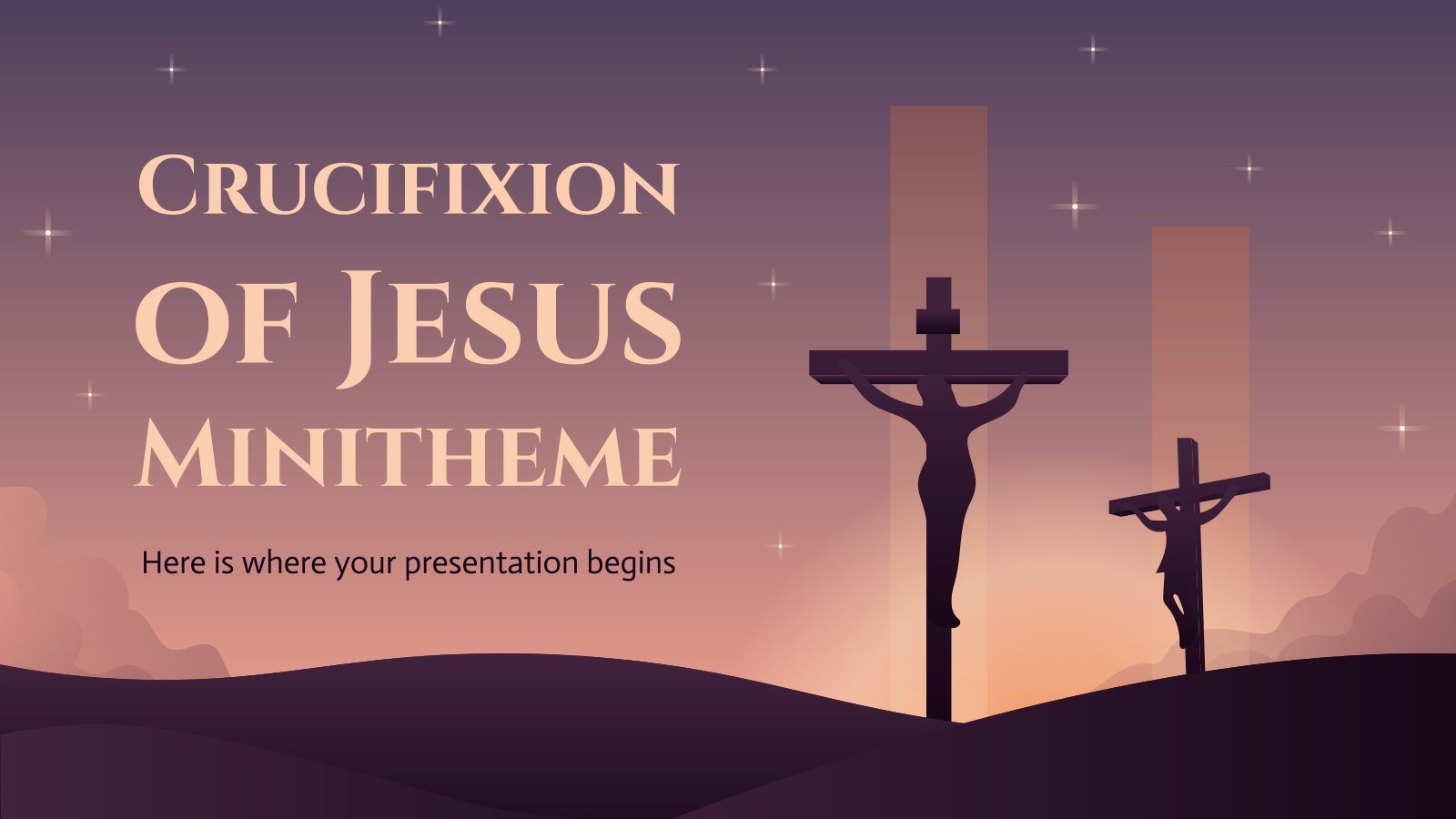
55 templates

ai technology
148 templates

citizenship
14 templates

13 templates

9 templates
Critical Thinking Lesson
Critical thinking lesson presentation, free google slides theme and powerpoint template.
Critical thinking appears to be a difficult matter to understand. Well, we can help you with the design of a presentation about that topic! You'll notice the colorful nature of the elements used in the slides, which may encourage viewers (or students!) to think about this concept. Try this template and use it in class!
Features of this template
- 100% editable and easy to modify
- 32 different slides to impress your audience
- Contains easy-to-edit graphics such as graphs, maps, tables, timelines and mockups
- Includes 500+ icons and Flaticon’s extension for customizing your slides
- Designed to be used in Google Slides and Microsoft PowerPoint
- 16:9 widescreen format suitable for all types of screens
- Includes information about fonts, colors, and credits of the free resources used
How can I use the template?
Am I free to use the templates?
How to attribute?
Attribution required If you are a free user, you must attribute Slidesgo by keeping the slide where the credits appear. How to attribute?
Related posts on our blog.

How to Add, Duplicate, Move, Delete or Hide Slides in Google Slides

How to Change Layouts in PowerPoint

How to Change the Slide Size in Google Slides
Related presentations.

Premium template
Unlock this template and gain unlimited access

Academia.edu no longer supports Internet Explorer.
To browse Academia.edu and the wider internet faster and more securely, please take a few seconds to upgrade your browser .
Enter the email address you signed up with and we'll email you a reset link.
- We're Hiring!
- Help Center

Lecture Notes on Logical reasoning conceptualization and critical thinking

Logical reasoning, conceptualization and critical thinking are essential for scientific thinking and research. The lecture notes exposes students to the importance of these three categories of knowledge for learning and knowing.
Related Papers
Open textbook
Matthew Van Cleave
An intro level text covering the basics of reasoning and argumentation, including some basic formal logic, and targeted at beginning undergraduates. I wrote it for a course I taught at Lansing Community College that covered both logic and critical thinking. It is an "open textbook" under a Creative Commons license (CC BY 4.0). https://creativecommons.org/licenses/by/4.0/
Dr Jason J Braithwaite
Informal Logic
Donald Hatcher
After critiquing the arguments against using formal logic to teach critical thinking, this paper argues that for theoretical, practical, and empirical reasons, instruction in the fundamentals of formal logic is essential for critical thinking, and so should be included in every class that purports to teach critical thinking.
Rupkatha Journal on Interdisciplinary Studies in Humanities
Galina Jasečková
A characteristic feature of modern society is the ever-expanding information space. Hidden information attacks harm the lives of individuals and society in general. In this regard, studies of critical thinking seem particularly important to us. Therefore, critical thinking is interpreted in the academic discourse mainly in connection with the effort to cope with the growing amount of misinformation and hate speech. While teachers and policymakers consider critical thinking an important educational goal, many are unclear about developing this competency in a school setting. For many key competencies, the question is whether and how they can be acquired through planned educational courses/programs. Although there are specific training programs for critical thinking as a core competency, their design and effectiveness are scientifically controversial. Instruction in critical thinking becomes extremely important because it allows individuals to gain a more comprehensive understanding of...
Oxford Handbooks Online
Kevin Dunbar
Sabina Saldanha
The Nairobi Journal of Literature
susan wandera
Veornita Sims
Edwin Brandon , Norma Sirbrathhie
Internet Encyclopedia of Philosophy
Jamie C Watson
Loading Preview
Sorry, preview is currently unavailable. You can download the paper by clicking the button above.
RELATED PAPERS
Federico Simonetta
Muhammad Firdaus Saputra
Katherine Bless Karlsen
Chemical Geology
Christoph Korte
Alex Jackson
Themistoklis Gogas
Current Microbiology
MUHAMMAD ISHAQ JAVED
The Canadian Journal of Addiction
Joseph De Leo
SELİM ÖZARSLAN
Melaka Hari Ini - Akhbar Rasmi Kerajaan Negeri Melaka
Zaipul Anwar Zainu
Divulgatio. Perfiles académicos de posgrado
Fabián Martins
Aeronautics and Aerospace Open Access Journal
marco cabero
Nuclear Technology and Radiation Protection
RUDN Journal of Law
Ekaterina Rusakova
Qiana Houston
Energy Technology
Boris Bryskin , Alexander Kostylev
Discrete Mathematics
Omar Rosario Cayetano
Topology and its Applications
K59 Nguyen Thi Bich Nhu
Melanie Zúñiga
Mosharafa : jurnal pendidikan matematika
Novisita Ratu
Metabolites
Mohammad Aatif
JAMA Ophthalmology
Marilyn Escobedo
South African Journal of Occupational Therapy
Chantal Christopher
Neotropical Primates
Thomas Defler
IOP Conference Series: Materials Science and Engineering
Setya Chendra Wibawa
See More Documents Like This
RELATED TOPICS
- We're Hiring!
- Help Center
- Find new research papers in:
- Health Sciences
- Earth Sciences
- Cognitive Science
- Mathematics
- Computer Science
- Academia ©2024

- My presentations
Auth with social network:
Download presentation
We think you have liked this presentation. If you wish to download it, please recommend it to your friends in any social system. Share buttons are a little bit lower. Thank you!
Presentation is loading. Please wait.
LOGIC AND CRITICAL THINKING
Published by amdework araya Modified about 1 year ago
Similar presentations
Presentation on theme: "LOGIC AND CRITICAL THINKING"— Presentation transcript:
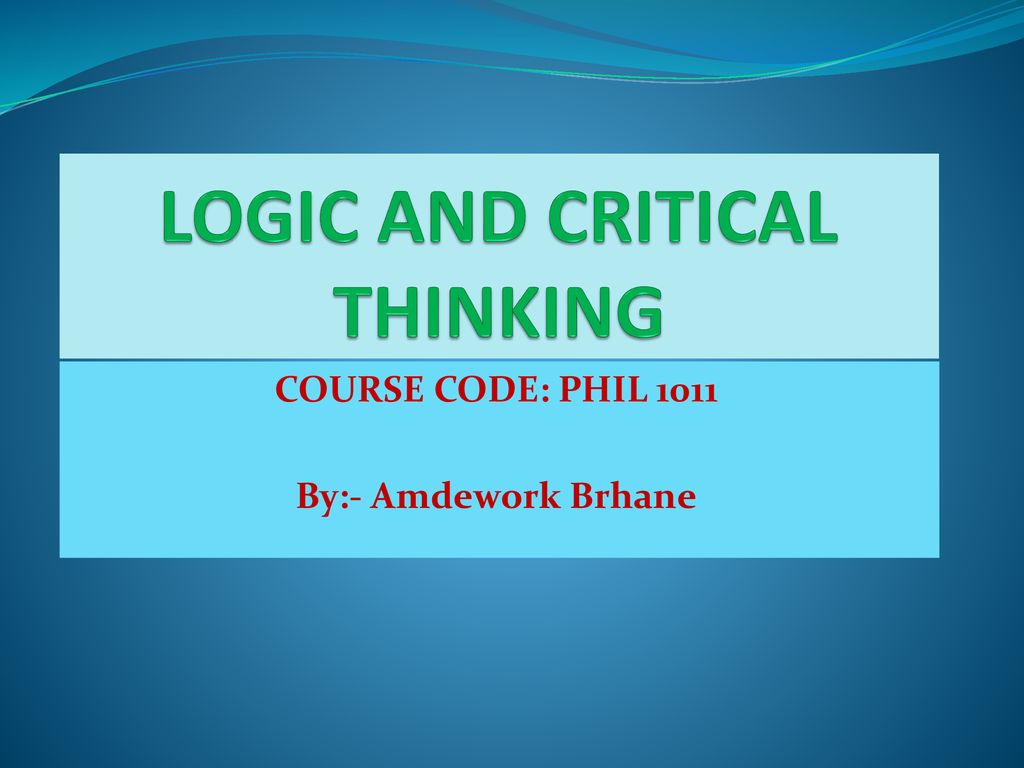
WORLD VIEWS: WHAT IS TRUE?

Dr. Paul R. Shockley: Worldview Thinking:. “Philosophy begins in wonder. And, at the end, when philosophic thought has done its best, the wonder remains.”

PHILOSOPHY, ITS MAIN CATEGORIES AND PROBLEMS

Computer Ethics PHILOSOPHICAL BELIEF SYSTEMS Chapter 1 Computer Ethics PHILOSOPHICAL BELIEF SYSTEMS Chapter 1 Hassan Ismail.

Introduction to Philosophy

Oleh: DEBBIE HARIMU (P ) 1 DEFINITIONS of PHILOSOPHY.

Misconceptions of Philosophy

Ways of Knowing Augsburg College NUR 306 Week One.

Phil 1: An Introduction to Philosophy

“Philosophy and the Search of wisdom”

Principle and philosophy of education

“PHILOSOPHY AND THE SEARCH OF WISDOM” Mrs. Karen Hernández 10th Grade.

Welcome to Philosophy and Ethics! Ms. Krall Room 347.

DEVELOPING A PHILOSOPHY Maurice M. Martinez. WESTERN PHILOSOPHY PHILOSOPHY-THE LOVE OF WISDOM [FROM THE GREEK WORDS: PHILEIN=TO LOVE & SOPHIA=WISDOM]

{ PHILOSOPHY Lesson 3 -The divisions of Philosophy A little Logic Part 1.

Definitions of Reality (ref . Wiki Discussions)

HZB301 Philosophy Room 158 Mr. Baker.

Welcome to Ethics Ethics and citizens rights DR. BURTON A. AGGABAO Professorial lecturer

Updated, 8/19/00. The Greek word, philosophia, means the love (philia) of wisdom (sophia)

Mormons do not feel threatened by science. They are not enemies of the rational world. They are not creationist. On human conduct, they tend to stress.
About project
© 2024 SlidePlayer.com Inc. All rights reserved.
- No category
Logic and Critical Thinking PPT 2o22 C-5
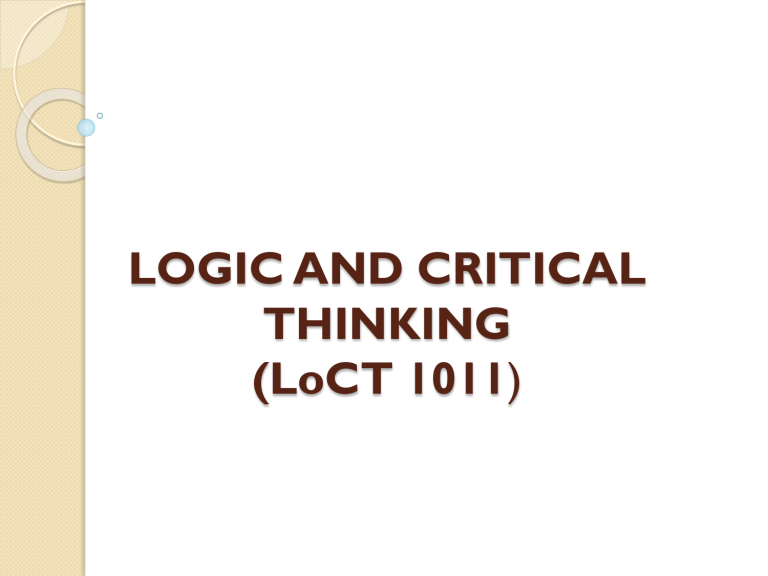
Related documents


Add this document to collection(s)
You can add this document to your study collection(s)
Add this document to saved
You can add this document to your saved list
Suggest us how to improve StudyLib
(For complaints, use another form )
Input it if you want to receive answer
- Data, AI, & Machine Learning
- Managing Technology
- Social Responsibility
- Workplace, Teams, & Culture
- AI & Machine Learning
- Diversity & Inclusion
- Big ideas Research Projects
- Artificial Intelligence and Business Strategy
- Responsible AI
- Future of the Workforce
- Future of Leadership
- All Research Projects
- AI in Action
- Most Popular
- The Truth Behind the Nursing Crisis
- Work/23: The Big Shift
- Coaching for the Future-Forward Leader
- Measuring Culture

The spring 2024 issue’s special report looks at how to take advantage of market opportunities in the digital space, and provides advice on building culture and friendships at work; maximizing the benefits of LLMs, corporate venture capital initiatives, and innovation contests; and scaling automation and digital health platform.
- Past Issues
- Upcoming Events
- Video Archive
- Me, Myself, and AI
- Three Big Points

How to Create Slides That Suit Your Superiors: 11 Tips
When you’re pitching ideas or budgets to execs in your organization, you need to deliver slides that fit those particular people just right. This checklist identifies the key considerations.

- Workplace, Teams, & Culture
- Leadership Skills

Carolyn Geason-Beissel/MIT SMR | Getty Images
I recently interviewed 20 of my customers, all in senior roles at Fortune 100 companies, and asked them their biggest pain point in presenting to higher-ups and even colleagues. What I heard consistently was that it can feel like Goldilocks bouncing from one option to the next, testing to figure out what’s “just right.” Does the audience want deep reports? Sparse slides? Something in between? Like … what?
Teams often come to presentation meetings with vast amounts of backup content just in case an exec wants to take a deep dive on any given point. There’s often a struggle to anticipate every direction attendees might want to go. It’s frustrating, and it’s not efficient.
Get Updates on Transformative Leadership
Evidence-based resources that can help you lead your team more effectively, delivered to your inbox monthly.
Please enter a valid email address
Thank you for signing up
Privacy Policy
There are many ways to build slides. I’m not just talking about crafting them well versus poorly. I’m talking about all of the important decisions regarding how to organize them, how much text to use, when to lean into a chart, the best ways to use bullets and color, and whether to include an appendix with additional information. Before you make your next proposal or request of the executive team, use this list of 11 tips for your next set of slides as a guide.
Four Things You Must Have in Every Exec’s Slides
Before we drill down into the harder aspects, the ones where your executives’ tastes may vary widely, let’s quickly cover four aspects that you can consider the building blocks — the basics you should never proceed without.
Start with an executive summary. Begin the slide deck with a tight executive summary that follows a three-act structure. First, start with stating the current realities. Second, clearly state the problem or opportunity your idea addresses and its potential impact. Third, explain how your recommendation solves the problem or exploits the opportunity and the next steps you’re proposing.
Have a logical organization. The arc of the deck — the package from beginning to end — should make sense. If your audience reads only the headline of every slide, the order should be coherent and make most of the case for you. The content below each slide’s headline must support the statement made in the title. Remove everything that doesn’t support your point; as writers will tell you, you sometimes need to “kill your darlings” when you’re editing.
Begin the slide deck with a tight executive summary that follows a three-act structure.
Make it skimmable. Help your audience to quickly grasp the point without getting bogged down in details. Create a clear visual hierarchy. Guide the reader’s eye through the content: Use bold headings, bullet points, and numbered lists to break down information into digestible pieces. Highlight key takeaways or conclusions in a different color or font size to draw attention to these critical points.
Focus on concise insights. Succinct statements with clear insights are everyone’s jam. Every slide should serve a purpose and contribute directly to the decision-making process. Distill complex information. Don’t use 100 words when 20 words will nail it. If you’re having difficulty trimming, consider using company-approved AI tools to help you take out the fluff.
Five Preferences to Confirm With the Person You Want to Reach
Now we’ll delve into what your particular audience does and does not want. If you haven’t yet, start by asking the person you’re presenting to what they generally prefer. They probably know themselves well but have not been asked to articulate how they like to receive information.
Ask how dense is too dense. Some executives prefer detailed slides with comprehensive data. Others favor a more high-level approach. You’re weighing how to balance informative content with readability, ensuring that slides are not overloaded yet are sufficiently detailed to support decision-making.
Confirm the delivery format and timing. Some execs like information presented to them. Others prefer a pre-read of the material followed by a discussion. I always recommend our tool Slidedocs (I’ve written a free e-book on them), which are visual documents using both words and images. The templates help presenters organize their thoughts into a document for a pre-read or a read-along. They are designed to be skimmable and able to travel through your organization without the help of a presenter.
I’m a huge fan of pre-reads and prefer to use my time in meetings to ask questions and build alignment. If your audience didn’t review your material in advance, ask at the top of the meeting whether they would like you to present it or would prefer to read through it and then discuss it.
Find out how much data visualization they prefer. Charts, graphs, photos, and illustrations often communicate complex data more clearly than words alone. When execs can see what you’re saying, they often can better understand the impact of your idea. Does the exec want to understand exact numbers? Bar charts allow them to move their eyes across a series of specifics. Does the exec want to know the shape of a trend over time? Line charts can show the pattern. (See “Classic Charts Communicate Data Quickly.”) Some prefer charts with annotations that draw attention to what you think is the most important point. Others want to make their own conclusions from the data.
One of my clients, the CEO of a massive commercial real estate company, doesn’t want anything visualized. He prefers numbers, only in a table, and only in two colors — black and red. You might think this is archaic. But the fact that he’s clear to his teams about what he wants takes all the mystery out of how to communicate with him.
When the stakes are high, have a conceptual thinker help with diagrams and concepts. If you don’t have one on your team, and when it’s high stakes, find an internal designer to help you or hire one. You can’t afford to have the baby (your idea) thrown out with the bathwater (terrible slides).
Identify which details need spelling out. How well do the people you’re presenting to know the landscape and function of the company and products you’re talking about? For example, if your engineering team threw a slide into a deck about an issue that requires executive approval, do the execs all speak geek? Or do you need to explain the technology so that they will really understand the ask? Either eliminate internal jargon and acronyms or unpack those bits, especially if your proposal deeply involves expertise outside of the executives’ domain.
Ask whether appendices will be useful. When you’re organizing a presentation, you often troll data, read through complicated reports, and even hire external experts to figure out what’s best for the company. Do your execs want access to that supporting data? You can add a document to the end of the presentation as an appendix to show all of the data and source material. This allows the main content of the slides to remain focused and accessible while still providing comprehensive background information for those who want more.
Two Tips to Improve Your Presentation Skills
Getting materials in place is the biggest step. They will be your best tools for selling your ideas. But there are two extra areas to pay attention to as a presenter: how you handle questions and how you use every experience to improve.
Anticipate questions, and practice your answers. Before you have your meeting, gather a small team to challenge every point you make. Invite colleagues you trust to role-play as “a rapidly inquisitive exec” or “the doubting naysayer exec” so you are prepared to present your idea well. They’re gonna grill you, and practicing will help you remain unruffled when it happens.
Related Articles
Ask for feedback after the presentation. Establish a feedback loop with those you presented to. Ask what worked well and how you can improve. If attendees don’t have the time, find people who have had their ideas funded and talk to them about what they did that worked. Advice and some perspective will help you nail your performance even better next time.
Empathetically understanding your audience members and how they process information, whether it’s executives or peers, sets up your ideas for success. Clarity creates efficiency. When a presentation fits just right, you’ve given your great thinking the best chance of moving through your organization and having maximum impact.
About the Author
Nancy Duarte is CEO of Duarte Inc. , a communication company in the Silicon Valley. She’s the author of six books, including DataStory: Explain Data and Inspire Action Through Story (Ideapress Publishing, 2019).
More Like This
Add a comment cancel reply.
You must sign in to post a comment. First time here? Sign up for a free account : Comment on articles and get access to many more articles.
- Preferences

LOGICAL and CRITICAL THINKING - PowerPoint PPT Presentation
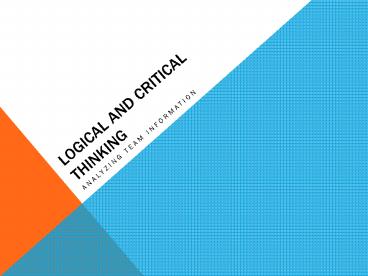
LOGICAL and CRITICAL THINKING
Evaluating (cont d.) criteria for analysis. the information s source. expertise . qualifications. reputation. habits of communication: search. justice. preference ... – powerpoint ppt presentation.
- Analyzing Team Information
- Norms for Critical Analysis
- Quality of data is everyones responsibility
- Analysis is a collaborative activity
- Analysis is objective, not personal
- Disagreement is part of cooperative analysis
- The team owns all the information
- Criteria for Analysis
- The informations source
- Qualifications
- Habits of communication
- Preference for public vs. private motivations
- Respect for dissent
- Ethical inferences
- The information itself
- Internet infos virtual locations
- Data dont prove people do
- Careful, objective, cooperative analysis is key
- Make rational decisions
- Objectivity leads to ethical decisions
- Drawing Conclusions
- Analyzing warrants
- Identifying reservations
- Qualifying conclusions
- Examining complete arguments
- Testing Reasoning
- Inductive reasoning
- Deductive reasoning
- Cause-and-effect reasoning
- Fallacious reasoning
- hasty generalizations
- false analogies
- false dilemmas
- special pleading
- red herrings
- circumlocution
- appeal to authority
- Nature and Effects
- Cultural and Gender Influences
PowerShow.com is a leading presentation sharing website. It has millions of presentations already uploaded and available with 1,000s more being uploaded by its users every day. Whatever your area of interest, here you’ll be able to find and view presentations you’ll love and possibly download. And, best of all, it is completely free and easy to use.
You might even have a presentation you’d like to share with others. If so, just upload it to PowerShow.com. We’ll convert it to an HTML5 slideshow that includes all the media types you’ve already added: audio, video, music, pictures, animations and transition effects. Then you can share it with your target audience as well as PowerShow.com’s millions of monthly visitors. And, again, it’s all free.
About the Developers
PowerShow.com is brought to you by CrystalGraphics , the award-winning developer and market-leading publisher of rich-media enhancement products for presentations. Our product offerings include millions of PowerPoint templates, diagrams, animated 3D characters and more.


LOGIC AND CRITICAL THINKING
Dec 20, 2019
200 likes | 217 Views
LOGIC AND CRITICAL THINKING. The Way to the Good Reasoning and Making Good Argument. 時間: 92 年 10 月 18 日 地點:東吳大學外雙溪 主講:米建國 東吳大學哲學系. What Is Critical Thinking?. Think it twice: Don’t take things for granted so easily.
Share Presentation

Presentation Transcript
LOGIC AND CRITICAL THINKING The Way to the Good Reasoning and Making Good Argument 時間:92年10月18日 地點:東吳大學外雙溪 主講:米建國 東吳大學哲學系
What Is Critical Thinking? • Think it twice: Don’t take things for granted so easily. • Always ask the why-question: Try to find out the reason (the premises) why certain claim (the conclusion) can be supported. • Examine and evaluate the relationship between the reasons and the claim.
Paradoxes • Self-defeating paradox: The concept of “all powerful” God • Zeno’s paradox: An apparently unacceptable conclusion derived by apparently acceptable reasoning from apparently acceptable premises • Semantic paradox: The liar’s paradox • The lawyer’s paradox • Prisoner’s dilemma • Russell’s paradox (Barber’s paradox) • The lottery paradox
What is logic? • Logic is not an empirical science • Formal or informal science • Logic v.s.Psychology: 1. The Laws of Thinking 2. The Science of Reasoning 3. The Science of Argument • The study of the methods and principles used to distinguish good (correct) from bad (incorrect) reasoning or argument. • The way to the good reasoning (making good argument) and critical thinking
What Is an Argument? • An argument is the fundamental structure of the reasoning. • An argument consists of premises and conclusion. • An argument is used to provide reasons for supporting some claim or proposal. • Logic aims to the study of the various forms of argument. • The ultimate goal of logic is to evaluate arguments.
The Standard Form of Argument • P = premise, C = conclusion • There must be some kind of supporting relationship between premises and conclusion. P1 P2 、 、 Pn (n≧1) C
Two Kinds of Argument • The traditional but mistaken distinction between deduction and induction: DeductionInduction Some general principles Some particular cases ↓ ↓ A particular case A general principle
Deductive Argument Deductive argument is the argument that the premises necessarily support the conclusion. P1 P2 、 、 Pn C
Inductive Argument Inductive argument is the argument that the premises probably support the conclusion. P1 P2 、 、 Pn C
Evaluating An Argument • There aretwo ways of evaluating an argument. • Formal logic is to use the deductive criterion for evaluating arguments. • Informal logic is to use the inductive criterion for evaluating argument.
The Criterion for Evaluating a Deductive Argument Deductive Argument Valid Arg. Invalid Arg. Sound Arg. Unsound Arg. Unsound Arg. Good Arg. Bad Arg Bad Arg.
The Criterion for Evaluating an Inductive Argument Inductive Argument Strong Arg. Weak Arg. Cogent Arg. Uncogent Arg. Uncogent Arg. Good Arg. Bad Arg. Bad Arg.
What Is a Good Argument
The Deductive Systems • The truth table methods for evaluating deductive arguments • The formal system of natural deduction: 1. Propositional logic 2. Predicate logic • The Aristotelian logic (Categorical Syllogism) • The axiomatic system
The Inductive Systems • The methods of analogy and the probable inference • Legal reasoning • Mill’s method and causality • Statistical reasoning and probability • Hypothetical reasoning
Informal Fallacies • A fallacy is an error in reasoning. • Fallacies of relevance: When an argument relies upon premises that are not relevant to its conclusion, and therefore cannot possibly establish its truth • Fallacies of weak induction: When the connection between premises and conclusion is not strong enough to support the reasoning • Fallacies of presumption, ambiguity, and grammatical analogy
The Uses of Logic • Evaluate someone else’s argument by exposing its structure • Set up your own argument • Solve problems and puzzles by answering the why-questions (giving the reasons) • Inference to the best through using the present evidences • Thinking effectively and making decision wisely
Logic and Critical Thinking • Why should we become a critical thinker? • Be the master of your own life • To ask “why?” is to ask for the reasons for some beliefs and opinions (that is, to find out the premises for a certain conclusion) • To evaluate how the reasons successfully support the claim (that is, to evaluate how the premises support the conclusion ) • A critical thinker is a truth-pursuer, and logic is truth-preserving.
- More by User
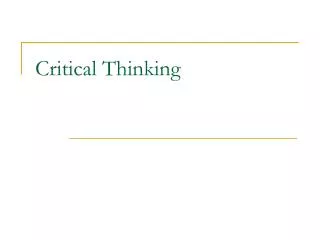
Critical Thinking
Critical Thinking Some notes on the midterm If you think we missed credit, please submit your defense by email to [email protected] by Nov. 1. Please address each question separately according to the grading criteria . We do make mistakes, so don't be afraid to address your concerns.
820 views • 17 slides

CRITICAL THINKING
CRITICAL THINKING. The Discipline The Skill The Art. Assumptions . Purpose -Teach critical thinking process as it applies to completing WIC nutritional counseling Assumes audience knows: Basic nutrition and risk factors
1.08k views • 19 slides

Critical Thinking. Introduction to the Unit Keith Jones. Critical Thinking. Critical Thinking 10 Credit Point M Level Dr Keith Jones Core Unit for all the MSc/MA Pathways. Introduction & Rationale.
1.57k views • 19 slides
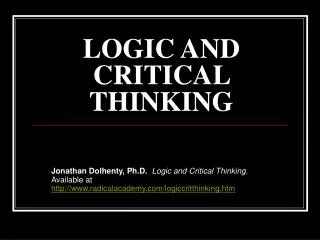
LOGIC AND CRITICAL THINKING. Jonathan Dolhenty, Ph.D. Logic and Critical Thinking. Available at http://www.radicalacademy.com/logiccritthinking.htm. TRUTH AND THINKING. Truth is the object of thinking. Some truths are obvious; others are difficult to acquire.
1.03k views • 26 slides

Critical Thinking. Foundations of Science. Let’s think about it. What makes people effective critical thinkers?. Critical Thinking. Critical Thinkers… Are flexible Identify biases & assumptions Maintain an air of skepticism Separate facts from opinions Don’t oversimplify
442 views • 4 slides

Critical Thinking. Richard M. Schwartzstein, MD Executive Director, Carl J. Shapiro Institute for Education and Research Faculty Associate Dean for Medical Education Professor of Medicine Harvard Medical School. Critical Thinking. Do you do it?. Critical Thinking. Do you do it?
841 views • 47 slides

Critical Thinking. The Brain. One trillion cells compose the brain. 100 billion of them are neurons. This makes the number of possible journeys through the brain almost infinite. Your Comments…. “The unexamined life is not worth living.”. Socrates. Plato.
820 views • 32 slides

Critical Thinking. Sitting on top of your shoulders is one of the finest computers on the earth. But, like any other muscle in your body, it needs to be exercised to work its best. That exercise is called THINKING. I think, therefore I am. - Rene Descartes. What is critical thinking?.
1.1k views • 17 slides

2.84k views • 19 slides

Critical thinking
Student Services . Critical thinking. Orientation 2011 Angela Dierks. www.bbk.ac.uk/mybirkbeck . Student Services . Critical thinking in everyday life. You think critically all the time for example when deciding not to buy a particular product
713 views • 13 slides

Critical Thinking. GEA 101 Fall 2012. introduction. Course Particulars. Instructor: Dr. Michael Johnson Office: Room HSH219, Ho Sin Hang Building Office Hours: Wednesdays 15:00 to 16:00 Email: [email protected] Office Telephone: 2616 7455. Course Website.
658 views • 44 slides
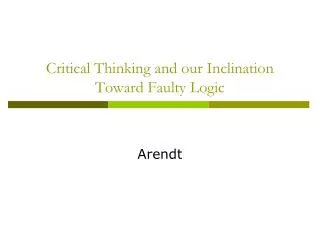
Critical Thinking and our Inclination Toward Faulty Logic
Critical Thinking and our Inclination Toward Faulty Logic. Arendt. Critical Thinking & our inclination toward Faulty Logic. You have the right to question what you see, hear, and read.
667 views • 35 slides

LOGIC AND CRITICAL THINKING. Lecture 11 – Scientific Reasoning I. REVIEW. First, let’s go over homework from last time. REVIEW. Last time we talked about the relationship between correlation and causation.
700 views • 43 slides

Critical Thinking: An Introduction. Logic and Logical Fallacies
Critical Thinking: An Introduction. Logic and Logical Fallacies. Lecture II. Truth Tables and Logical Operators. Face it…some things are either true or false (specifying this formally is called “propositional calculus”) A “proposition” is a meaningful statement
711 views • 23 slides

Critical Thinking. “The important thing is not to stop questioning. Curiosity has its own reason for existing” - Albert Einstein. Critical Thinking in Your Life. Personal Life What constitutes a healthy diet? Which investment is better for my family? Why? Professional Life
1.23k views • 17 slides

Logic and Critical Thinking
Logic and Critical Thinking. CCC8001 2 nd Term 2013. introduction. Course Particulars. Instructor: Dr. Michael Johnson Office: Room HSH219, Ho Sin Hang Building Office Hours: Monday s 15:00 to 16:00 Email: [email protected] Office Telephone: 2616 7052.
1.12k views • 49 slides
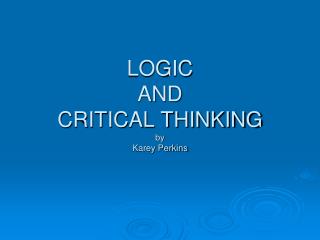
LOGIC AND CRITICAL THINKING by Karey Perkins
LOGIC AND CRITICAL THINKING by Karey Perkins. RHETORICAL APPEALS: USING LOGOS, ETHOS, PATHOS. LOGOS = LOGIC and REASON= Soundness of facts, evidence, statistics, and reasoning; soundness of authority’s statements outside self; well-documented evidence
892 views • 71 slides
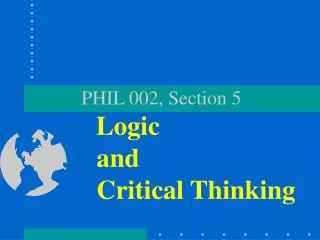
PHIL 002, Section 5 Logic and Critical Thinking
PHIL 002, Section 5 Logic and Critical Thinking. About this course. About this course. There’s so many of us!!!. About this course. There’s so many of us!!! Instructional staff. About this course. There’s so many of us!!! Instructional staff
275 views • 15 slides
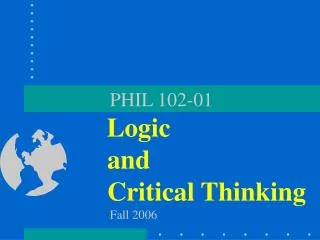
PHIL 102-01 Logic and Critical Thinking Fall 2006
PHIL 102-01 Logic and Critical Thinking Fall 2006. About this course. About this course. There’s so many of us!!!. About this course. There’s so many of us!!! Instructional staff. About this course. There’s so many of us!!! Instructional staff
322 views • 20 slides
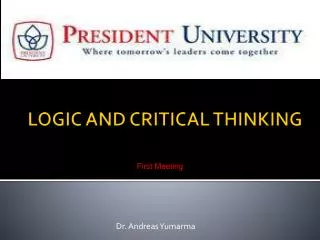
Dr. Andreas Yumarma. LOGIC AND CRITICAL THINKING. First Meeting. Sense of Logic. Study of the methods and principles used to distinguish correct from incorrect reasoning (Irving M. Copy & Carl Cohen, 1990)
483 views • 11 slides

Critical thinking about critical thinking
Critical thinking about critical thinking. Paula Owens and John Hopkin. Workshop description Based on two practical activities, this workshop will explore what critical thinking means in the context of geography, apply it to some examples and consider how to apply it in the classroom
940 views • 28 slides
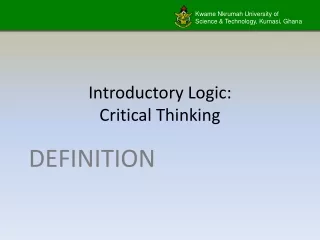
Introductory Logic: Critical Thinking
Introductory Logic: Critical Thinking. DEFINITION. Definitions. A definition is an attempt to explain the meaning of a word by using a different word or phrase that has the same meaning. The word being defined is called the definiendum (Latin for “to be defined”).
467 views • 32 slides

IMAGES
VIDEO
COMMENTS
This is an introductory textbook in logic and critical thinking. The goal of the textbook is to provide the reader with a set of tools and skills that will enable them to identify and evaluate arguments. The book is intended for an introductory course that covers both formal and informal logic. As such, it is not a formal logic textbook, but is closer to what one would find marketed as a ...
Logic and Critical Thinking. CCC8001 2 nd Term 2013. introduction. Course Particulars. Instructor: Dr. Michael Johnson Office: Room HSH219, Ho Sin Hang Building Office Hours: Monday s 15:00 to 16:00 Email: [email protected] Office Telephone: 2616 7052.
Formal or informal science Logic v.s.Psychology: 1. The Laws of Thinking 2. The Science of Reasoning 3. The Science of Argument The study of the methods and principles used to distinguish good (correct) from bad (incorrect) reasoning or argument. The way to the good reasoning (making good argument) and critical thinking.
This is an introductory textbook in logic and critical thinking. Both logic and critical thinking centrally involve the analysis and assessment of arguments. "Argument" is a word that has multiple distinct meanings, so it is important to be clear from the start about the sense of the word that is relevant to the study of logic.
Free Google Slides theme and PowerPoint template. Critical thinking appears to be a difficult matter to understand. Well, we can help you with the design of a presentation about that topic! You'll notice the colorful nature of the elements used in the slides, which may encourage viewers (or students!) to think about this concept.
This specialization introduces general standards of good reasoning and offers tools to improve your critical thinking skills. These skills will help you determine when an argument is being given, what its crucial parts are, and what it assumes implicitly. You will also learn how to apply deductive and inductive standards for assessing arguments ...
Critical Thinking: An Introduction to. Logic and Logical Fallacies. Lecture II. Fall 2008. Truth Tables and Logical Operators Face it…some things are either true or false (specifying this formally is called "propositional calculus") A "proposition" is a meaningful statement Limited number of operators: (not, and, or, if…then, if and ...
logic and critical thinking power point - Free download as Powerpoint Presentation (.ppt / .pptx), PDF File (.pdf), Text File (.txt) or view presentation slides online. logic and critical thinking lecture notes
Logical reasoning, conceptualization and critical thinking are essential for scientific thinking and research. The lecture notes exposes students to the importance of these three categories of knowledge for learning and knowing. ... After critiquing the arguments against using formal logic to teach critical thinking, this paper argues that for ...
Introduction to Logics and Critical Thinking Slides - View presentation slides online.
1 LOGIC AND CRITICAL THINKING COURSE CODE: PHIL 1011 By:- Amdework Brhane. 2 ... Download ppt "LOGIC AND CRITICAL THINKING" Similar presentations . WORLD VIEWS: WHAT IS TRUE? Dr. Paul R. Shockley: Worldview Thinking:. "Philosophy begins in wonder. And, at the end, when philosophic thought has done its best, the wonder remains."
Logic is the way of correct thinking in the process of argumentation. Sense of Critical Thinking • Critical Thinking is reasonable and reflective thinking that is focused on deciding what to believe and do (Cf. Norris and Ennis, 1989) • Critical Thinking is a mode of thinking -about any subject, content or problem- in which the thinker ...
First, fallacious arguments are very, very common and can be. quite persuasive, at least to the causal reader or listener.You. can find dozens of examples of fallacious reasoning in. newspapers, advertisements, and other sources. . Second, it is sometimes hard to evaluate whether an. argument is fallacious. .
reasoning. An argument consists of premises and conclusion. An argument is used to provide reasons for. supporting some claim or proposal. Logic aims to the study of the various forms of. argument. The ultimate goal of logic is to evaluate. arguments. 6.
Logic and Critical Thinking. Logic and Critical Thinking. CCC8001 2 nd Term 2013. introduction. Course Particulars. Instructor: Dr. Michael Johnson Office: Room HSH219, Ho Sin Hang Building Office Hours: Monday s 15:00 to 16:00 Email: [email protected] Office Telephone: 2616 7052. 1.12k views • 49 slides
Introductory Logic: Critical Thinking. Introductory Logic: Critical Thinking. DEFINITION. Definitions. A definition is an attempt to explain the meaning of a word by using a different word or phrase that has the same meaning. The word being defined is called the definiendum (Latin for "to be defined"). 466 views • 32 slides
Start with an executive summary. Begin the slide deck with a tight executive summary that follows a three-act structure. First, start with stating the current realities. Second, clearly state the problem or opportunity your idea addresses and its potential impact.
Presentation Transcript. Critical Thinking: Chapter 2 Two Kinds of Reasoning. Valid Argument • A valid argument has this characteristic: On the assumption that the premises are true, it is impossible for the conclusion to be false. • Example: [Premise] Every philosopher is a good mechanic, and [premise] Emily is a philosopher.
LOGICAL and CRITICAL THINKING. Analyzing Team Information. 2. Evaluating Information Critically. Norms for Critical Analysis. Quality of data is everyones responsibility. Analysis is a collaborative activity. Analysis is objective, not personal. Disagreement is part of cooperative analysis.
Logic and Critical Thinking. Logic and Critical Thinking. CCC8001 2 nd Term 2013. introduction. Course Particulars. Instructor: Dr. Michael Johnson Office: Room HSH219, Ho Sin Hang Building Office Hours: Monday s 15:00 to 16:00 Email: [email protected] Office Telephone: 2616 7052. 1.12k views • 49 slides